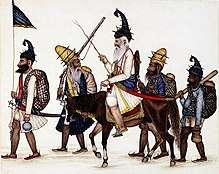Dharamyudh (Sikhism)
In Sikhism, dharamyudh, dharam-yudh or dharam yudh is a term which is variously translated as 'religious war',[1][2][3] 'war of righteousness',[2] 'war in defence of righteousness',[4] or 'war for justice'.[3] Though some core tenets in the Sikh religion are understood to emphasise peace and nonviolence, especially before the 1606 execution of Guru Arjan by Mughal emperor Jahangir,[5] military force may be justified if all peaceful means to settle a conflict have been exhausted, thus resulting in a dharamyudh.[4]
| Part of a series on |
| Sikhism |
|---|
 |
|
|
Practices
|
|
|
General topics
|
Etymology
The first part of the term dharamyudh comes from Punjabi dharm or dharam (ਧਰਮ), which is usually translated as 'religion',[4] although it is said to 'encapsulate a wider understanding of appropriate conduct, moral order, and bodily discipline' than the words 'religion' and 'religious practice' in English do.[6] It is derived from Sanskrit dhárma (धर्म),[6] which has various possible meanings[4] including 'morality', 'justice', 'law', 'religion', 'devotion' and 'sacrifice'. The second part is a cognate of Hindi yuddh (युद्ध, meaning 'war'), derived from Sanskrit yuddhá (युद्ध, meaning 'battle', 'fight' or 'war'). The meaning of the term dharamyudh appears to have been somewhat ambiguous in the writings of the early Sikh Gurus, ranging from 'an interior, individual, spiritual struggle' to 'a war to defend one's beliefs', but by the 18th century, it was increasingly interpreted as 'a religiously sanctioned war against Muslims in particular', which scholars attribute to the changing political circumstances that the Sikhs found themselves in, or moved themselves into.[6]
Hinduism also has a similar concept called dharma-yuddha that appears several times in the Mahabharatha.
History
Militarisation of Sikhism (17th century)
Sikhism, founded in the late 15th century by Guru Nanak in the Punjab region, which was conquered by the Mughal Empire in the early 16th century, is generally considered to have been pacifist until the early 17th century.[5] Perceiving the growth of the Sikhs as a threat, the Mughal authorities began to persecute them, and in 1606 Sikh leader Guru Arjan was executed by Mughal emperor Jahangir, apparently for refusing to convert to Islam, though this remains disputed.[5] Sikhism split into two movements: one led by Guru Arjan's son Guru Hargobind began to regard Guru Arjan as a martyr, became more political and militaristic, and started organising armed rebellions against the Mughals; the other led by Guru Arjan's older brother Prithi Chand focused on peace and nonviolence, and rejected uprisings.[5] The radicalised Sikhs justified violence as 'self-defence' against Mughal oppression,[7] trained themselves to become warriors or nihang, and organised themselves in jathas. In 1621, the first acts of open rebellion led to the eruption of the Mughal-Sikh Wars.
Sikh imperialism (1716–1849)

Over the course of several decades, small Sikh states known as misls combined to form the Sikh Confederacy in 1716, that jointly fought against Mughal power. Professionalisation of combat led the last Guru Gobind Singh to create the Khalsa, a special class of Sikh warriors, in 1699.[8] In 1735, the jathas would be merged into a single army, the Dal Khalsa. During the Afghan–Sikh Wars, the Sikhs expanded even further and in 1799 the Sikh Empire was founded, which would last until 1849, when it was defeated and annexed by the British East India Company.[9] Sikh warriors would continue to serve in the British Indian army.
Modern militancy (1970s–present)
In the second half of the 20th century, the separatist Khalistan movement emerged, demanding an independent Sikh state in Indian Punjab. The main political party, Akali Dal, used the term Dharam Yudh Morcha (morcha meaning 'agitation'[3]) to rally Sikh nationalists in their campaigning, especially in 1982.[3][2] Hereafter, several years of violence committed by Sikh militants to achieve their demands followed.[10] In June 1984, the conflict reached its zenith during Operation Blue Star, when Indian security forces stormed the holiest Sikh site, the Golden Temple in Amritsar, where Khalistan militants had set up their headquarters.[11] In retaliation, the two Sikh bodyguards of Prime Minister Indira Gandhi assassinated her in October 1984.[12] The killing was followed by many anti-Sikh riots as well as more Sikh militant attacks which cost dozens of lives.[13] In the end, Sikh militancy did not bring about a separate state, and the Indian Government achieved victory in 1995.[14]
References
- Dhavan, Purnima (2011). When Sparrows Became Hawks: The Making of the Sikh Warrior Tradition, 1699-1799. Oxford: Oxford University Press. p. 76. ISBN 9780199756551. Retrieved 16 September 2019.
- Chima, Jugdep S. (2008). The Sikh Separatist Insurgency in India: Political Leadership and Ethnonationalist Movements. New Delhi: SAGE Publications India. p. 70. ISBN 9788132105381. Retrieved 16 September 2019.
- Schnabel, Albrecht; Gunaratna, Rohan (2015). Wars From Within: Understanding And Managing Insurgent Movements. London: Imperial College Press. p. 194. ISBN 9781783265596. Retrieved 16 September 2019.
- Fenech, Louis E.; McLeod, W. H. (2014). Historical Dictionary of Sikhism. Plymouth & Lanham, Maryland: Rowman & Littlefield. pp. 99–100. ISBN 9781442236011. Retrieved 16 September 2019.
- Syan, Hardip Singh (2013). Sikh Militancy in the Seventeenth Century: Religious Violence in Mughal and Early Modern India. London & New York: I.B.Tauris. pp. 3–4, 252. ISBN 9781780762500. Retrieved 15 September 2019.
- Dhavan, pp. 14–15.
- Syan, pp. 8–10.
- Fenech, p. 178.
- Fenech, p. 37.
- Chima, p. 71.
- Encarta-encyclopedie Winkler Prins (1993–2002) s.v. "Sikhs. §3. Autonomie". Microsoft Corporation/Het Spectrum.
- Encarta-encyclopedie Winkler Prins (1993–2002) s.v. "Gandhi, Indira".
- Encarta-encyclopedie Winkler Prins (1993–2002) s.v. "India. §5.5 Tweede regeerperiode Indira Gandhi".
- Gates, Scott; Roy, Kaushik (17 February 2016). "Unconventional Warfare in South Asia: Shadow Warriors and Counterinsurgency". Routledge. p. 163. Retrieved 10 October 2017 – via Google Books.